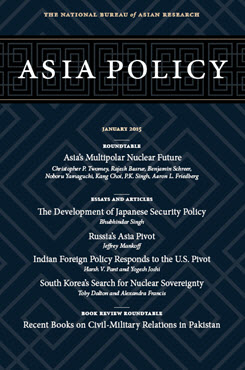Introduction
Dangerous Dynamism in Asia's Nuclear Future
This is one of seven essays in the roundtable “Approaching Critical Mass: Asia’s Multipolar Nuclear Future.”
Christopher P. Twomey is Associate Professor of National Security Affairs at the U.S. Naval Postgraduate School in Monterey, California.
This is one of seven essays in the roundtable Approaching Critical Mass: Asia’s Multipolar Nuclear Future.
One of the defining elements of the post–Cold War era has been the diffusion of power away from the two superpowers. This has occurred across a wide variety of measures, including nuclear weaponry. In particular, since the end of the Cold War, proliferation across states and increasing arsenal capabilities within some of them have characterized Asia’s international security affairs. Given the importance of nuclear weapons to the development and conduct of the Cold War, we should expect these changes in the post–Cold War era to be similarly important.
These changes have been the subject of significant scholarly analysis already. Dubbed the “second nuclear age” by eminent strategists Colin Grey and Paul Bracken, this epoch seems to pose new dangers and challenges. [1] Important debates have developed about the degree to which the most engaged dyad—India and Pakistan—is more dangerous than the dyads in the Cold War, to which nuclear weapons provided apparent stability. [2] Other studies have examined a broader range of countries facing this new environment. [3] A burgeoning quantitative literature surveys both Cold War and post–Cold War crises and dyads to evaluate a wide range of hypotheses about stability and coercive leverage. [4]
Endnotes
[1] Colin S. Gray, The Second Nuclear Age (Boulder: Lynne Rienner Publishers, 1999); and Paul Bracken, Fire in the East: The Rise of Asian Military Power and the Second Nuclear Age (New York: HarperCollins, 1999).
[2]See, for example, S. Paul Kapur, “Ten Years of Instability in a Nuclear South Asia,” International Security 33, no. 2 (2008): 71–94; Vipin Narang, “Posturing for Peace: Pakistan’s Nuclear Postures and South Asian Stability,” International Security 34, no. 3 (2009): 38–78; Zafar Khan, “The Arrival of Tactical Nuclear Weapons in South Asia: Deterrent Stability or Instability?” Comparative Strategy 32, no. 5 (2013): 402–17; and Michael D. Cohen, “How Nuclear South Asia Is Like Cold War Europe,” Nonproliferation Review 20, no. 3 (2013): 433–51.
[3] Muthiah Alagappa, ed., The Long Shadow: Nuclear Weapons and Security in 21st Century Asia (Stanford: Stanford University Press, 2008).
[4] For more on stability and coercive leverage, see Erik Gartzke, Jeffrey M. Kaplow, and Rupal N. Mehta, “Nuclear Deterrence and the Structure of Nuclear Forces” (paper presented at the International Studies Association Annual Convention and the Midwest Political Science Association Annual Meeting, 2013); Matthew Kroenig, “Nuclear Superiority or the Balance of Resolve? Explaining Nuclear Crisis Outcomes,” International Organization 67, no. 1 (2013): 141–71; and Mark S. Bell and Nicholas L. Miller, “Questioning the Effect of Nuclear Weapons on Conflict,” Journal of Conflict Resolution (2013).
About Asia Policy
Asia Policy is a peer-reviewed scholarly journal presenting policy-relevant academic research on the Asia-Pacific that draws clear and concise conclusions useful to today’s policymakers. Asia Policy is published quarterly in January, April, July, and October and accepts submissions on a rolling basis. Learn more


